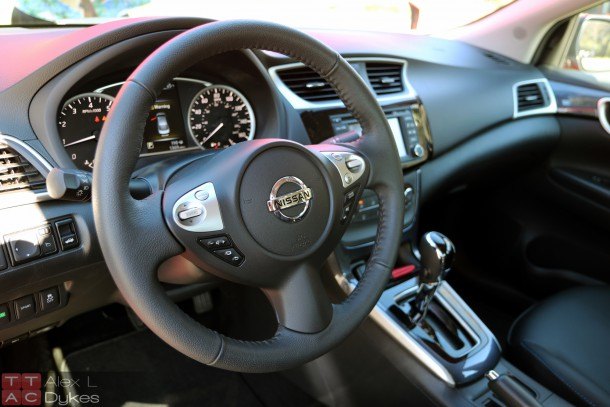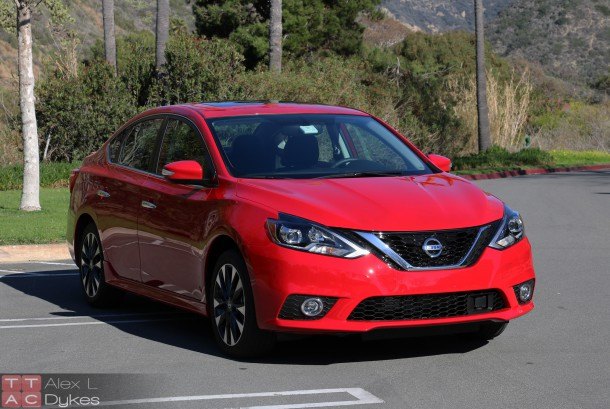2016 Nissan Sentra Review - Nissan's Compact Goes Premium

Traditional car shoppers are moving away from small sedans and toward compact crossovers. That’s the conventional wisdom used to explain the slowing sales we see in some models. But could there be another reason? Could it simply be a lack of focus and attention to the compact segment?
There is one model that’s seen a meteoric rise in sales since 2013: the Sentra. Nissan’s complete overhaul three years ago and aggressive pricing doubled Sentra sales since then, moving it from a “top 15” player in sales to number five in 2015.
In an effort to maintain the trajectory, Nissan opted for a major refresh after just three years on sale. (Sounds like the Honda plan with the Civic, doesn’t it?) Perhaps the key to compact success is a combination of frequent updates and more gadgets for shoppers to choose from. That sums up the 2016 Sentra perfectly.
Exterior
Up front, Nissan grafts a new bumper, hood and quarter panels to the Sentra, making it more homogeneous within Nissan’s lineup. The new look also injects some much-needed personality into the Sentra with a simpler chrome grille, more aggressive headlamps with optional LED beams and deeper creases in the sheet metal. The design manages to be more fresh and modern than the 2015 Sentra without looking awkward from some angles, a failing seen on the 2016 Civic. The Sentra is not as exciting as a Mazda3 to my eye, but it certainly looks fresher than the Elantra, Forte and Focus.
Interior
Part of the Sentra’s success comes from its size. It offers 80 inches of combined legroom, which is five inches more than the Ford Focus and just 2/10ths of an inch behind the Ford Fusion.
As we’ve seen in other Nissans, the trunk is unusually deep and offers 15.1 cubic feet of stowable volume. This allows 24-inch roller bags (the largest you can carry on a domestic flight) to be stowed upright. Our tester successfully swallowed 10 such roller bags, a feat difficult for much larger sedans like the Camry and Accord. Next time you’re at the rental counter, you’d do well to take the Sentra over the Fusion or 200.
Infotainment & Gadgets
For $18,550, the SV gains a 5-inch LCD in the dash with smartphone app integration, hands-free text message support, Siri Eyes Free, a backup camera, XM Radio and six speakers. Optional on SV and SR and standard on SL is a 5.8 inch version of the same system that adds navigation and voice commands. Top trims can be equipped with a 10-speaker Bose sound system.
Like Honda, Nissan is betting on active safety, but Nissan’s approach is different. SV trims allow the addition of blind spot monitoring with cross traffic detection, a feature not found on the Civic. SR and SL shoppers can add a $1,230 technology package that bundles full speed radar cruise control, automatic braking and Nissan’s OnStar-like telematics services. This system will take you to a complete stop, but won’t hold you at the stop like Honda’s will.
Nissan’s package is $230 more than Honda Sensing and lacks the lane keeping and road departure mitigation system you find in the Civic, but does include telematics. On the flip side, the Sentra is considerably less expensive than a Civic, so an SL sedan equipped with radar cruise would still be thousands less than a comparably equipped Honda.
Drivetrain
Power is sent to the front wheels via, you guessed it, a continuously variable transmission. Like the Versa’s transaxle, this CVT uses a 2-speed planetary gearset to broaden the range. In broad terms, you start out with the gearset in low and the CVT in its lowest range. When the CVT hits the highest ratio, the planetary gearset switches to high and the CVT switches back to low. This design allows the CVT a broader ratio spread than you find in most compact sedans. The high-low shift is noticeable under hard acceleration if you pay attention, but it’s effectively masked by the programming that imitates a stepped automatic when using anything more than 3/8ths throttle. Nissan still offers a six-speed manual, but it’s relegated to the base model only.
Drive
Nissan has tried their best to disguise the CVT’s stepless nature by programming “shifts” that happen any time you command more than 3/8ths throttle. However, the transmission acts just as CVTs always have when driven conservatively. In moderately aggressive driving, the new step logic makes a convincing imitation. The shifts feel “mushy” beyond that, however, with the transmission slipping into the next ratio with a more leisurely pace than a traditional automatic.
The newly tweaked suspension has firmed up the ride and settled the rear end. New tires with grippier compounds have been fitted to all trims, but the sectional width has stayed resolutely narrow at 205. A new steering rack and additional chassis bracing helps complete the package and the Sentra feels altogether more capable than before. Yet, up against stiff competition, the Nissan still ends up being a middling experience in terms of performance and handling.
Although Nissan bumped the price tag on the Sentra by $230 for 2016, the MSRP is still aggressively low, especially when you consider how large the Sentra is compared to some other compact sedans. SV, SR and SL trims undercut the Focus, Civic and Mazda3 by a notable margin, and even manage to be less expensive in some configurations than a similarly equipped Hyundai or Kia. With the most recent tweaks, the Sentra is not only less expensive, but fresher as well.
Comparisons with Honda’s Civic show an even larger delta. The Nissan is at least $2,000 less than the Honda across the range. When you factor in the deeper discounts we often see on Nissan lots, the gap between the Sentra and Civic grows.
The 2016 Sentra doesn’t break any new ground. The dynamics are still in the middle of the pack, and acceleration and braking are moderate. The safety features may be new to the Sentra, but are not new to the segment. However, like the 2013 Sentra I reviewed several years ago, the Nissan continues to be a great value. With sales of competitive sedans declining, Nissan’s aggressive pricing, large cabin and well bundled options explain its popularity.
Enthusiast shoppers are likely to gravitate toward Honda’s new turbo engines or the high-performance Focus models while Nissan fans live in hope the next refresh will include an SR with wider tires and more power under the hood. That would turn the Sentra from the logical, rational option to more of an emotional choice.
Nissan provided the vehicle at a launch event which included travel and a stay at a swanky hotel in Southern California.

More by Alex L. Dykes
Latest Car Reviews
Read moreLatest Product Reviews
Read moreRecent Comments
- ToolGuy The only way this makes sense to me (still looking) is if it is tied to the realization that they have a capital issue (cash crunch) which is getting in the way of their plans.
- Jeff I do think this is a good thing. Teaching salespeople how to interact with the customer and teaching them some of the features and technical stuff of the vehicles is important.
- MKizzy If Tesla stops maintaining and expanding the Superchargers at current levels, imagine the chaos as more EV owners with high expectations visit crowded and no longer reliable Superchargers.It feels like at this point, Musk is nearly bored enough with Tesla and EVs in general to literally take his ball and going home.
- Incog99 I bought a brand new 4 on the floor 240SX coupe in 1989 in pearl green. I drove it almost 200k miles, put in a killer sound system and never wish I sold it. I graduated to an Infiniti Q45 next and that tank was amazing.
- CanadaCraig As an aside... you are so incredibly vulnerable as you're sitting there WAITING for you EV to charge. It freaks me out.





























































Comments
Join the conversation
My dad has a 2013 Sentra in SR trim. I have a few complaints after driving it for a little while. 1) CVT. It sucks. Its noisy, lurchy, and overly aggressive in 0-30 acceleration but useless at 50-80. Plus when it goes up a hill there is a smell of burnt clutch/transmission. I think the unit is going to fail soon and that brings me to the second point 2) reliability. its questionable. especially with this CVT tranny. We had a 2001 sentra before and it was good until he replaced it in 2013. It had about 150k on it before he traded it in and it still went through a couple of non maintenance items such as o2 sensors/catalytic converter x2/ECU failed due to moisture (covered under warranty). From what ive read on the b15 sentra form the headgaskets were also a common issue on the 2001's. Thus i cant imagine his 2013 is much better. Luckly he leased it and therefore we'll be dumping this thing shortly in 2016. 3) The front seat bottoms are incredibly short. I have no thigh support at all. There isnt even an option to add a bolster to it so your SOL. People with long legs, watch out for this one.
Just noticed a similarity between this grille and the one Nissan had on the Sentra from 04-06. I'm not its biggest fan, but it's far more attractive than anything Honda is offering right now.